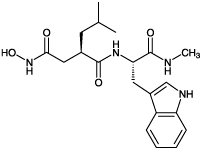Potent broad-spectrum hydroxamate inhibitor of matrix metalloproteinases (MMPs). Ki values have been reported for the following human MMPs: MMP-1 (fibroblast collagenase): 0.4nM; MMP-2 (gelatinase A): 0.5nM; MMP-3 (stromelysin-1): 27nM; MMP-7 (matrilysin): 3.7nM; MMP-8 (neutrophil collagenase): 0.1nM; MMP-9 (gelatinase B): 0.2nM; MMP-12 (metalloelastase): 3.6nM; MMP-14 (MT1-MMP): 13.4nM; MMP-26 (endometase): 0.36nM. Also inhibits MMP-10, MMP-13, MMP-15, MMP-17, MMP-20, MMP-21, TACE, ADAM19, other ADAMs, anthrax lethal factor, neprilysin, leucine aminopeptidase, and DPPIII. Typical concentration range for use in tissue culture is 10-25µM. This inhibitor has also been used in vivo.
Product Details
| Alternative Name: | Galardin, Ilomastat, N-[(2R)-2-(Hydroxamidocarbonylmethyl)-4-methylpentanoyl]-L-tryptophan methylamide |
| |
| Formula: | C20H28N4O4 |
| |
| MW: | 388.5 |
| |
| CAS: | 142880-36-2 |
| |
| Formulation: | Lyophilized solid. |
| |
| Purity: | ≥98% (HPLC) |
| |
| Appearance: | White to off-white powder. |
| |
| Solubility: | Soluble in DMSO (at least 25mM) or 100% ethanol (10mg/ml) |
| |
| Shipping: | Blue Ice |
| |
| Long Term Storage: | -20°C |
| |
| Regulatory Status: | RUO - Research Use Only |
| |
Please mouse over
Product Literature References
ADAM17 Mediates Proteolytic Maturation of Voltage-Gated Calcium Channel Auxiliary α2δ Subunits, and Enables Calcium Current Enhancement: I. Kadurin, et al.; Function (Oxf.)
3, zqac013 (2022),
Abstract;
Surface cholesterol-enriched domains specifically promote invasion of breast cancer cell lines by controlling invadopodia and extracellular matrix degradation: M. Maja, et al.; Cell. Mol. Life Sci.
79, 417 (2022),
Abstract;
Extracellular domain shedding of the ALK receptor mediates neuroblastoma cell migration: H. Huang, et al.; Cell Reports
36, 109363 (2021),
Abstract;
NK cells eliminate Epstein-Barr virus bound to B cells through a specific antibody-mediated uptake: E. Alari-Pahissa, et al.; PLoS Pathog.
17, e1009868 (2021),
Abstract;
Enhancing protective microglial activities with a dual function TREM2 antibody to the stalk region: K. Schlepckow, et al.; EMBO Mol. Med.
12, e11227 (2020),
Abstract;
Full Text
Protocatechuic acid attenuates anterior cruciate ligament transection‑induced osteoarthritis by suppressing osteoclastogenesis: J. Zhang, et al.; Exp. Ther. Med.
19, 232 (2020),
Abstract;
Full Text
SARS-CoV-2 spike protein promotes IL-6 trans-signaling by activation of angiotensin II receptor signaling in epithelial cells: T. Patra, et al.; PLoS Pathog.
16, e1009128 (2020),
Abstract;
Full Text
Loss of kallikrein‐related peptidase 7 exacerbates amyloid pathology in Alzheimer's disease model mice: K. Kidana, et al.; EMBO Mol. Med.
2018, e8184 (2018),
Abstract;
Full Text
Podosome assembly is controlled by the GTPase ARF1 and its nucleotide exchange factor ARNO: N.B. Rafiq, et al.; J. Cell Biol.
216, 181 (2017),
Abstract;
Phenotype anchoring in zebrafish reveals a potential role for matrix metalloproteinases (MMPs) in tamoxifen's effects on skin epithelium: S.M. Bugel, et al.; Toxicol. Appl. Pharmacol.
18, 296 (2016),
Application(s): Cell culture,
Abstract;
Cross-talk between lysophosphatidic acid receptor 1 and tropomyosin receptor kinase a promotes lung epithelial cell migration: L. Nan, et al.; Biochim. Biophys. Acta
1863, 229 (2015),
Application(s): Cell culture,
Abstract;
Inside-out Regulation of Ectodomain Cleavage of Cluster-of-Differentiation-44 [CD44] and of Neuregulin-1 requires Substrate Dimerization: M. Hartmann, et al.; J. Biol. Chem.
290, 17041 (2015),
Application(s): Cell Culture,
Abstract;
Full Text
Membrane Cholesterol Modulates LOX-1 Shedding in Endothelial Cells: M. Gioia, et al.; PLoS One
10, e0141270 (2015),
Application(s): Hydroxamate inhibitor,
Abstract;
Full Text
PCSK6-mediated corin activation is essential for normal blood pressure: S. Chen, et al.; Nat. Med.
21, 1048 (2015),
Application(s): Protease inhibitor,
Abstract;
Fluorescent substrates for the proteinases ADAM17, ADAM10, ADAM8, and ADAM12 useful for high-throughput inhibitor screening: M. L. Moss et al.; Anal. Biochem.
366, 144 (2007),
Abstract;
Activity-based probes for the proteomic profiling of metalloproteases: A. Saghatelian, et al.; Proc. Natl. Acad. Sci. USA
101, 10000 (2004),
Abstract;
Evidence for disulfide involvement in the regulation of intramolecular autolytic processing by human adamalysin19/ADAM19: T. Kang et al.; Exp. Cell. Res.
298, 285 (2004),
Abstract;
Tetrahydroisoquinoline based sulfonamide hydroxamates as potent matrix metalloproteinase inhibitors: D. Ma et al.; Bioorg. Med. Chem. Lett.
14, 47-50 (2004),
Abstract;
The structural basis for substrate and inhibitor selectivity of the anthrax lethal factor: B. E. Turk et al.; Nat. Struct. Mol. Biol.
11, 60 (2004),
Abstract;
Membrane-anchored CD40 is processed by the tumor necrosis factor-alpha-converting enzyme. Implications for CD40 signaling: C. Contin et al.; J. Biol. Chem.
278, 32801 (2003),
Abstract;
The intermediate S1’ pocket of the endometase/matrilysin-2 active site revealed by enzyme inhibition kinetic studies, protein sequence analyses, and homology modeling: H. I. Park et al.; J. Biol. Chem.
278, 51646 (2003),
Abstract;
The structure and regulation of the human and mouse matrix metalloproteinase-21 gene and protein: G. N. Marchenko et al.; Biochem. J.
372, 503 (2003),
Abstract;
Matrix metalloproteinases contribute to brain damage in experimental pneumococcal meningitis: S. L. Leib; Infect. Immun.
68, 615 (2000),
Abstract;
Catalytic activities and substrate specificity of the human membrane type 4 matrix metalloproteinase catalytic domain: Y. Wang et al.; J. Biol. Chem.
274, 33043 (1999),
Abstract;
Inhibition of membrane-type 1 matrix metalloproteinase by hydroxamate inhibitors: an examination of the subsite pocket: M. Yamamoto et al.; J. Med. Chem.
41, 1209 (1998),
Abstract;
Inhibition of matrix metalloproteinase activity inhibits smooth muscle cell migration but not neointimal thickening after arterial injury: M. P. Bendeck et al.; Circ. Res.
78, 38 (1996),
Abstract;
Low molecular weight inhibitors in corneal ulceration: R. E. Galardy et al.; Ann. N. Y. Acad. Sci.
732, 315 (1994),
Abstract;
Reversal of experimental autoimmune encephalomyelitis with a hydroxamate inhibitor of matrix metalloproteases: K. Gijbels et al.; J. Clin. Invest.
94, 2177 (1994),
Abstract;












